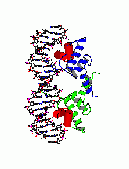Table1: Schedule 1999
| Class |
Date |
Subject |
Homeworka |
1 |
1/21 |
Course and Field Overview:
- What is molecular modeling and how has it evoled?
- What are the practical applications and important questions?
|
1: Introduction to web browing
and searching, sequence and
structural databases, and early
molecular modeling literature.
Read papers 1,2,19,32. |
2 |
1/28 |
- Continuation of the overview on biomolecular modeling and
simulation, from drug design to new materials
- Discussion of the 1959 paper of Alder and Wainwight: difficulties
then and now
- Introduction ot interesting biomolecular modeling problems: protein
folding, protein misfolding, nucleic acid/protein interactions, and RNA folding
(Transparency Set 1 and Lecture Notes 1 [preface and Chapter1])
|
2: Retrieval of structural information from the Protein Data Bank (PDB), an the display,
manipulation, and analysis of three-dimensional biomolecular structures with the Insight II
molecular graphics package. Explore kinemage tutorials.
Read papers 4, 29, 30, 33. |
| 3 |
2/4 |
- Minitutorial on protein structure: aminoacid repertoire, primary to quaternary
structure, protein structure classification
- Kinemage tutorial demonstration: folding motifs and major protein classes
|
3: Construction and analysis of the pentapeptide Met-enkephalin with the InsightII program.
Read papers 2, 3, 5. |
| 4 |
2/11 |
- Discuss homework assingments 1 and 2
- Minitutorial on nucleic acid structure: building blocks, backbone
confirmational
|
4: Generation and analysis of Ramachandran plots for proteins and introduction
to the NDB
Read papers 22,28
|
| 5 |
2/18 |
Guest Lecturer: The Nucleic Acid Database and the
'New Protein Databank'
(RCSB), Prof. Helen Berman (Rutgers university, Department of Chemistry), Director
of NDB and RCSB
|
5: Analysis of Protein/DNA Complexes with Insight and NDB
Read papers 6,20
|
| 6 |
2/25 |
- Discuss homework assignment 4
- Computational and theoretical approaches to structure prediction
(from the quantum-mechanical to the molecular mechanical description)
(Transp. 4 and Lecture Notes 5)
|
6: (MIDTERM): Sequence/Structure/Function Relationships in Protein,
A Contest (Due 3/15)
Read paper 21
|
| 7 |
3/1 |
Guest Lecture: Biomolecular Electrostatics and NMR Refinement, Dr. Dave
Case (Scripps Institute, Department of Molecular Biology), a developer
of AMBER and expert in biomolecular simulations
|
7: Molecular mechanics force fields: approximations, variations, and the
assessment of results with respect to experiment and other simulations
Read papers 12,13,16,23
|
| 8 |
3/5 |
Amer. Chem. Soc. 1990 videotapes:
Molecular Modeling in Biological Systems:
1-Peter Kollman, "Methods in molecular Modeling", 4-Panel Discussion. |
|
| 9 |
3/11 |
Guest Lecturer: Computation of Protein Conformation,
Prof. Harold Scheraga (Cornell University, Department of Chemistry), pioneer
of protein force fields and computation of protein structure
|
8: A bit of programming: nonbonded versus bonded energy computations.
bReading list
|
| 10 |
3/25 |
MIDTERM class presentatins
|
|
| 11 |
4/1 |
- Continue Midterm presentations
- Force Field Debate!
|
9: (TERM PROJECT):
The Successes (failures?) of
Molecular Modeling
Reading papers 9,17,18
|
| 12 |
4/8 |
-
Molecular mechanics force fields--origin, variations, and
parameterization
- Special topics -- molecular topology:
book-keeping and data structures, potential energy differentiation
(Transp. Notes 5,6,7)
- Special issues in nonbonded energy computations--spherical
cutoffs, fast electrostatics by
the multipole method, periodic boundary condictions,
and the Ewald summation
(Transp. Notes 8)
|
10: Experiments in Geometry Structure Optimization: Minimizaton
of Biphenyl with InsightII/Discover.
Reading papers 11.
|
| 13 |
4/15 |
- Go over Assignment 8, including
general discussion of programming and timing strategies
(Notes on Assignment 8)
- Optimization techniques for multivariate
functions in computational chemistry
(Transp. Notes 9)
|
11: A global optimization contest for a pentapeptide!
Reading papers 24,25. |
| 14 |
4/22 |
Monte Carlo Simulations
|
12: An exercise in Monte Carlo
Reading papers 26,27,31. |
| 15 |
4/29 |
Molecular dynamics simulations-theory and practice |
| 16 |
?? |
Molecular dynamics simulatons - continued
(Transp. Notes 10) |
TERM PROJECT DUE |


